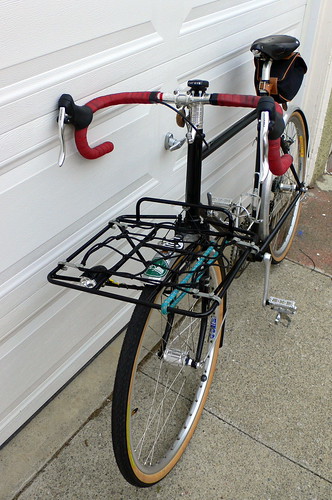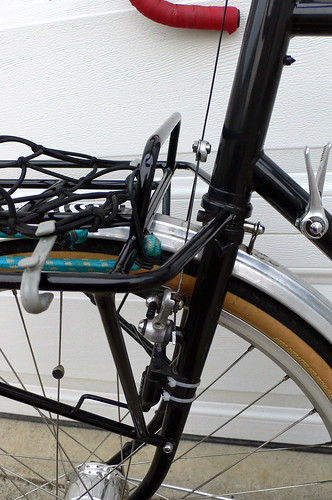 Miles Whitmore of Roseland Cycles posted on the Kogswell yahoo group that he had enough tubings to make 5 more porteur racks designed to go on P/R's fork, and Roseland might not make these racks in the future. I emailed him to reserve a 650b version right the way. 10 days later, I met Miles in Berkeley not too far from my apartment--it turns out that Miles and his partner is moving Roseland down to Berkeley from Santa Rosa, and current works out of a garage a few blocks away--and grabbed the rack from him.
Miles Whitmore of Roseland Cycles posted on the Kogswell yahoo group that he had enough tubings to make 5 more porteur racks designed to go on P/R's fork, and Roseland might not make these racks in the future. I emailed him to reserve a 650b version right the way. 10 days later, I met Miles in Berkeley not too far from my apartment--it turns out that Miles and his partner is moving Roseland down to Berkeley from Santa Rosa, and current works out of a garage a few blocks away--and grabbed the rack from him.The installation seemed easy. The rack is designed to connect to the mid-fork braze-ons and the fork crown braze-ons. I threaded in the 5mm bolts to attach the rack at the mid-fork, then realize that the rack struts meant to attach to the fork crown braze-ons were not exactly on the spot. Also, the fork crown braze-ons on the Kogswell weren't tapped, so I spent some effort getting the thread on the 6mm bolt to catch. After some pulling, the rack went on the fork. I then drilled a hole on the fender to attach to the fender tap under the rack, and installed the B&M IQ Cyo on the light holder on the rack. I am also using a porteur rack bag that Swift Industries makes on the rack.
I have ridden around time to buy groceries, etc. on the bike, and it feels not much different than when I was using the VO rack. However, on several hilly workouts in the Berkeley Hills, the restored suppleness in the front end on fast descent is certainly noticeable--the bike feels spriter, more responsive, and I feel more confident taking a turn at high-speed.
It is comparable in weight as the VO rack, and its attachment to the mid-fork braze-ons instead of the fork drop-outs means that I can safely put this bike on buses whose bike rack uses a front-wheel-hook to secure the bikes. The only nitpicking complaint I have is that the light holder is placed too high--my IQ Cyo properly adjusted to illuminate the road barely not stick out beyond the rack platform. When the porteur bag sits on the rack, it places pressure on the top of the light. I might have to use a VO light holder to solve the problem. But otherwise I am really happy with the rack so far.


